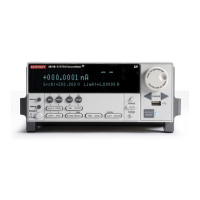2600S-901-01 Rev. C / January 2008 Return to Section Topics 9-11
Series 2600 System SourceMeter® Instruments Reference Manual Section 9: System Expansion (TSP-Link)
NOTE For this example, myscript is defined on the remote node.
To execute a script defined on the remote node:
node[N].execute("myscript()")
It is recommended that you copy large scripts to a remote node to improve system performance.
see “Copying test scripts across the TSP-Link network” on page 9-12 for more information.
Coordinating overlapped operations in remote groups
Errors occur if you send a command to a node in a remote group running an overlapped operation.
All nodes in a group must be in the overlapped idle state before the master node can send a
command to the group.
Use the waitcomplete command to:
• Group leader and master node: To wait for all overlapped operations running in the
local group to complete
• Master node only: To wait for all overlapped operations running on a remote group to
complete
• Master node only: To wait for all groups to complete overlapped operations
For additional information, reference the Instrument Control Library command waitcomplete.
The following code is an example on how to issue the waitcomplete command from the master
node:
-- Waits for each node in group G to complete all overlapped operations.
waitcomplete(G)
-- Waits for all groups on the TSP-Link network to complete overlapped operations.
waitcomplete(0)
The group leader can issue the waitcomplete command to wait for the local group to complete all
overlapped operations.
The following code is an example of how to issue the waitcomplete command:
-- Waits for all nodes in a local group to complete the overlapped operations.
waitcomplete()
Using the data queue for real-time communication
You cannot access the reading buffers or global variables from any node in a remote group while a
node in that group is performing an overlapped operation. You can use the data queue to retrieve
data from any node in a group performing an overlapped operation. In addition, the master node
and the group leaders can use the data queue as a way to coordinate activities.
The data queue uses the first-in, first-out (FIFO) structure to store data. Nodes running test scripts
in parallel can store data in the data queue for real-time communication. Each Series 2600 has an
internal data queue. You can access the data queue from any node at any time.
You can use the data queue to post numeric values, strings, and tables. Tables in the data queue
consume one entry. A new copy of the table is created when the table is retrieved from the data
queue. The copy of the table does not contain any references to the original table or any
subtables.
To add or retrieve values from the data queue and to view the capacity, see “Instrument Control
Library” on page 12-1 for more information.

